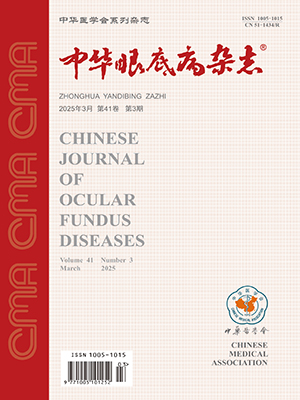| 1. |
孙立梅, 李松珊, 曹丽明, 等. 成人眼弓蛔虫病的临床特征分析[J]. 中华眼底病杂志, 2020, 36(9): 685-690. DOI: 10.3760/cma.j.cn511434-20200722-00348.Sun LM, Li SS, Cao LM, et al. Clinical characteristics of ocular toxocariasis in adults[J]. Chin J Ocul Fundus Dis, 2020, 36(9): 685-690. DOI: 10.3760/cma.j.cn511434-20200722-00348.
|
| 2. |
刘敬花, 李松峰, 邓光达, 等. 儿童眼弓蛔虫病临床特点分析[J]. 中华实验眼科杂志, 2019, 37(5): 371-375. DOI: 10. 3760/cma.j.issn.2095-0160.2019.05.011. DOI: 10.3760/cma.j.issn.2095-0160.2019.05.011.Liu JH, Li SF, Deng GD, et al. Clinical characteristics of pediatric ocular toxocariasis[J]. Chin J Exp Ophthalmol, 2019, 37(5): 371-375. DOI: 10. 3760/cma.j.issn.2095-0160.2019.05.011. DOI: 10.3760/cma.j.issn.2095-0160.2019.05.011.
|
| 3. |
Jiang Z, Sun L, Ding X, et al. Cytokine profile in aqueous humor of patients with ocular toxocariasis[J/OL]. Front Med (Lausanne), 2022, 13: 9: 869976[2022-05-13]. https://pubmed.ncbi.nlm.nih.gov/35646978/. DOI: 10.3389/fmed.2022.869976.
|
| 4. |
Sun L, Huang L, Li S, et al. Safety and effectiveness of intravitreal dexamethasone implant in patients with ocular toxocariasis[J]. Br J Ophthalmol, 2023, 108(2): 238-243. DOI: 10.1136/bjo-2022-322244.
|
| 5. |
Fata A, Hosseini SM, Woo SJ, et al. Frequency of toxocara antibodies in patients clinically suspected to ocular toxocariasis, northeast of Iran[J]. Iran J Parasitol, 2021, 16(2): 305-311. DOI: 10.18502/ijpa.v16i2.6312.
|
| 6. |
Zhang T, Guo D, Xu G, et al. Ocular toxocariasis: long-term follow-up and prognosis of patients following vitrectomy[J]. Ocul Immunol Inflamm, 2020, 28(3): 517-523. DOI: 10.1080/09273948.2019.1597897.
|
| 7. |
Cunningham ET Jr, Zierhut M. Ocular toxocariasis[J]. Ocul Immunol Inflamm, 2021, 29(7-8): 1243-1245. DOI: 10.1080/09273948.2021.2018825.
|
| 8. |
周咏薇, 李秋明, 武佳卉, 等. 眼弓蛔虫病临床特征及治疗预后分析[J]. 中华眼底病杂志, 2023, 39(6): 483-488. DOI: 10.3760/cma.j.cn511434-20220124-00042.Zhou YW, Li QM, Wu JH, et al. Clinical characteristics and treatment prognosis of ocular toxocariasis[J]. Chin J Ocul Fundus Dis, 2023, 39(6): 483-488. DOI: 10.3760/cma.j.cn511434-20220124-00042.
|
| 9. |
胡小凤, 刘旭辉, 汪晓娟, 等. 成人和儿童眼犬弓蛔虫病临床表现差异及眼内液检测特点[J]. 中华眼底病杂志, 2021, 37(7): 503-508. DOI: 10.3760/cma.j.cn511434-20210303-00115.Hu XF, Liu XH, Wang XJ, et al. Difference of clinical characteristics in ocular toxocariasis between adults and children and characteristics of anti-toxocaria antibody in intraocular fluids[J]. Chin J Ocul Fundus Dis, 2021, 37(7): 503-508. DOI: 10.3760/cma.j.cn511434-20210303-00115.
|
| 10. |
Huang L, Sun L, Liu C, et al. Diagnosis of ocular toxocariasis by serum and aqueous humor lgG ELISA[J]. Transl Vis Sci Technol, 2021, 10(8): 33. DOI: 10.1167/tvst.10.8.33.
|
| 11. |
Iddawela D, Ehambaram K, Bandara P. Prevalence of toxocara antibodies among patients clinically suspected to have ocular toxocariasis: a retrospective descriptive study in Sri Lanka[J]. BMC Ophthalmol, 2017, 17(1): 50. DOI: 10.1186/s12886-017-0444-0.
|
| 12. |
Jiang Z, Sun L, Huang L, et al. Noninvasive diagnostic strategy of ocular toxocariasis based on clinical features[J]. Retina, 2022, 42(5): 934-941. DOI: 10.1097/IAE.0000000000003388.
|
| 13. |
孙浩, 李姣, 郭大东, 等. 眼弓蛔虫病的诊治进展[J]. 国际眼科杂志, 2022, 22(4): 587-591. DOI: 10.3980/j.issn.1672-5123.2022.4.12.Sun H, Li J, Guo DD, et al. Progress in diagnosis and treatment of ocular toxocariasis[J]. Int Eye Sci, 2022, 22(4): 587-591. DOI: 10.3980/j.issn.1672-5123.2022.4.12.
|
| 14. |
李肖春, 常青, 江睿, 等. 40例眼弓蛔虫病患者首诊临床特征分析[J]. 中华眼底病杂志, 2016, 32(1): 40-43. DOI: 10.3760/cma.j.issn.1005-1015.2016.01.010.Li XC, Chang Q, Jiang R, et al. Clinical characteristics of ocular toxocariasis patients on the first attendance[J]. Chin J Ocul Fundus Dis, 2016, 32(1): 40-43. DOI: 10.3760/cma.j.issn.1005-1015.2016.01.010.
|
| 15. |
张翔, 陈春丽, 刘晶晶, 等. 单眼牵引性视网膜脱离患儿房水与血清中犬弓蛔虫抗体的检测[J]. 眼科新进展, 2019, 39(2): 138-144. DOI: 10.13389/j.cnkirao.2019.0031.Zhang X, Chen CL, Liu JJ, et al. Detection of aqueous and serum toxocaracanis specific antibody in pediatric patients with unilateral retinal detachment[J]. Rec Adv Ophthalmol, 2019, 39(2): 138-144. DOI: 10.13389/j.cnkirao.2019.0031.
|
| 16. |
Bae KW, Ahn SJ, Park KH, et al. Diagnostic value of the serum anti-toxocara IgG titer for ocular toxocariasis in patients with uveitis at a tertiary hospital in Korea[J]. Korean J Ophthalmol, 2016, 30(4): 258-264. DOI: 10.3341/kjo.2016.30.4.258.
|
| 17. |
Abd El-Aal NF, Basha MAA, Eid AM. New insight into the diagnostic cut-off value of serum anti-toxocara lgG for ocular toxocariasis in uveitis patients[J/OL]. J Helminthol, 2018, 94: e12[2018-11-20]. https://pubmed.ncbi.nlm.nih.gov/30457059/. DOI: 10.1017/S0022149X18000895.
|
| 18. |
DE Visser L, Rothova A, DE Boer JH, et al. Diagnosis of ocular toxocariasis by establishing intraocular antibody production[J]. Am J Ophthalmol, 2008, 145(2): 369-374. DOI: 10.1016/j.ajo.2007.09.020.
|
| 19. |
Hu XF, Feng J, Kang H, et al. Clinical characteristics of ocular toxocariasis in adults in north China[J]. Int J Ophthalmol, 2022, 15(3): 401-406. DOI: 10.18240/ijo.2022.03.05.
|
| 20. |
Wang ZJ, Zhou M, Cao WJ, et al. Evaluation of the Goldmann-Witmer coefficient in the immunological diagnosis of ocular toxocariasis[J]. Acta Trop, 2016, 158: 20-23. DOI: 10.1016/j.actatropica.2016.02.013.
|
| 21. |
Hernanz I, Moll-Udina A, Llorenc BV, et al. Ocular toxocariasis: beyond typical patterns through the new imaging technologies[J]. Ocul Immunol Inflamm, 2021, 29(7-8): 1252-1258. DOI: 10.1080/09273948.2020.1793370.
|
| 22. |
Wang H, Tao Y. Clinical features and prognostic factors in Northern Chinese patients with peripheral granuloma type of ocular toxocariasis: a retrospective cohort study[J]. Ocul Immunol Inflamm, 2021, 29(7-8): 1259-1264. DOI: 10.1080/09273948.2020.1804592.
|
| 23. |
Jin Y, Shen C, Huh S, et al. Serodiagnosis of toxocariasis by ELISA using crude antigen of Toxocara canis larvae[J]. Korean J Parasitol, 2013, 51(4): 433-439. DOI: 10.3347/kjp.2013.51.4.433.
|




